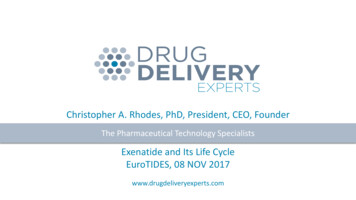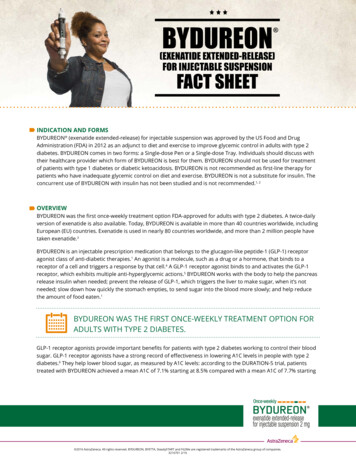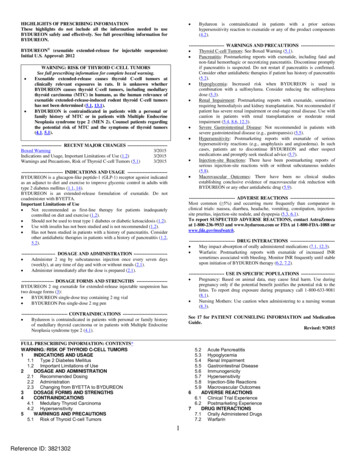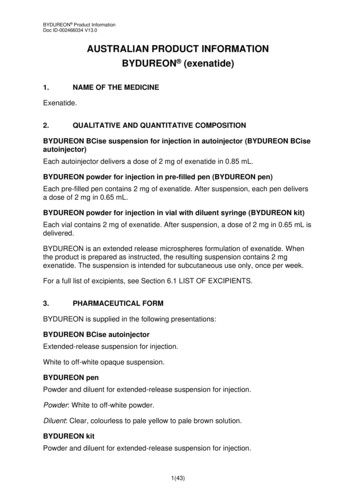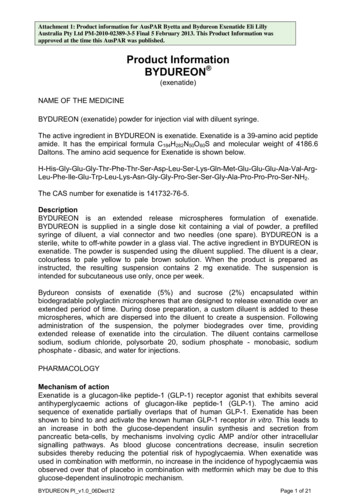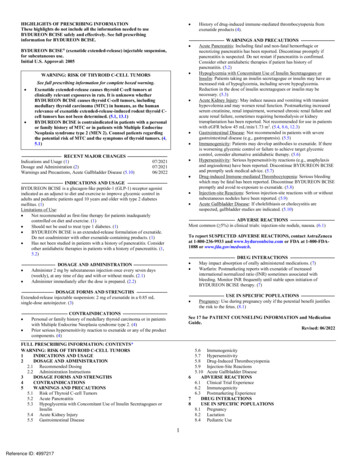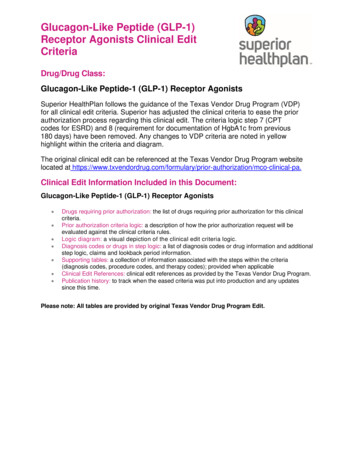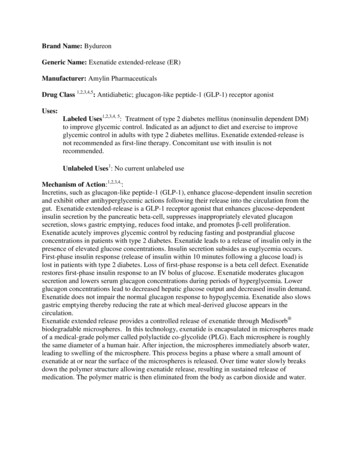
Transcription
Brand Name: BydureonGeneric Name: Exenatide extended-release (ER)Manufacturer: Amylin PharmaceuticalsDrug Class 1,2,3,4,5: Antidiabetic; glucagon-like peptide-1 (GLP-1) receptor agonistUses:Labeled Uses1,2,3,4, 5: Treatment of type 2 diabetes mellitus (noninsulin dependent DM)to improve glycemic control. Indicated as an adjunct to diet and exercise to improveglycemic control in adults with type 2 diabetes mellitus. Exenatide extended-release isnot recommended as first-line therapy. Concomitant use with insulin is notrecommended.Unlabeled Uses1: No current unlabeled useMechanism of Action:1,2,3,4,:Incretins, such as glucagon-like peptide-1 (GLP-1), enhance glucose-dependent insulin secretionand exhibit other antihyperglycemic actions following their release into the circulation from thegut. Exenatide extended-release is a GLP-1 receptor agonist that enhances glucose-dependentinsulin secretion by the pancreatic beta-cell, suppresses inappropriately elevated glucagonsecretion, slows gastric emptying, reduces food intake, and promotes β-cell proliferation.Exenatide acutely improves glycemic control by reducing fasting and postprandial glucoseconcentrations in patients with type 2 diabetes. Exenatide leads to a release of insulin only in thepresence of elevated glucose concentrations. Insulin secretion subsides as euglycemia occurs.First-phase insulin response (release of insulin within 10 minutes following a glucose load) islost in patients with type 2 diabetes. Loss of first-phase response is a beta cell defect. Exenatiderestores first-phase insulin response to an IV bolus of glucose. Exenatide moderates glucagonsecretion and lowers serum glucagon concentrations during periods of hyperglycemia. Lowerglucagon concentrations lead to decreased hepatic glucose output and decreased insulin demand.Exenatide does not impair the normal glucagon response to hypoglycemia. Exenatide also slowsgastric emptying thereby reducing the rate at which meal-derived glucose appears in thecirculation.Exenatide extended release provides a controlled release of exenatide through Medisorb biodegradable microspheres. In this technology, exenatide is encapsulated in microspheres madeof a medical-grade polymer called polylactide co-glycolide (PLG). Each microsphere is roughlythe same diameter of a human hair. After injection, the microspheres immediately absorb water,leading to swelling of the microsphere. This process begins a phase where a small amount ofexenatide at or near the surface of the microspheres is released. Over time water slowly breaksdown the polymer structure allowing exenatide release, resulting in sustained release ofmedication. The polymer matric is then eliminated from the body as carbon dioxide and water.
Pharmacokinetics:Absorption:TmaxSubQ: initial peak - 2 weeks; second peak - 6 to 7 weeks 1,2,3,4Vd23.8 L1,2,3,4t½2 10 weeks1,2,3,4No data reported1,2,3,465% to 76% (animal data)1Metabolism: Exenatide is metabolized by proteolytic degradation by dipeptidylpeptidase IV. Animal studies have demonstrated much greater resistance of exenatide todegradation by dipeptidyl peptidase IV compared to GLP-1. This difference may berelated to the presence of a glycine moiety at position 2 of exenatide; GLP-1 has analanine in this position, which is recognized by dipeptidyl peptidase IV.Elimination: Exenatide is predominantly eliminated by the kidney through glomerularfiltration.Efficacy:Best, J. H., R. R. Rubin, M. Peyrot, Y. Li, P. Yan, J. Malloy, and L. P. Garrison. "WeightRelated Quality of Life, Health Utility, Psychological Well-Being, and Satisfaction WithExenatide Once Weekly Compared With Sitagliptin or Pioglitazone After 26 Weeks ofTreatment." Diabetes Care 34.2 (2011): 314-19. Print.Study Design: randomized, double blind, double-dummy, multicenter clinical trial.Description of Study: Methods - This study was designed to assess the clinicaloutcomes, patient reported outcomes, and safety after 26 weeks of treatment withexenatide once weekly compared with maximum approved doses of sitagliptin orpioglitazone in patients with type 2 diabetes currently treated with metformin. Patientswere randomized into one of 3 groups: (1) exenatide 2mg injection weekly placebocapsule. (2) sitagliptin 100mg daily placebo injection weekly. (3) pioglitazone 45 mgdaily placebo injection weekly. Weight-related quality of life, health utility,psychological well-being, and diabetes treatment satisfaction were assessed at baselineand week 26. Mean group changes from baseline to week 26 were estimated byANCOVA. Results - Weight-related quality of life total scores improved significantly inthe exenatide once weekly and sitagliptin arms only; the exenatide once weekly groupexperienced significantly greater improvement than the pioglitazone group in weightrelated quality of life total scores and in several domain scores (See table 2 in study).Health utility scores improved significantly for exenatide once weekly and sitagliptingroups (P 0.05) with no significant difference between the exenatide once weekly
group and the pioglitazone group. All groups experienced significant improvements onthe psychological well-being global scale and all six domain scores, with no significantdifference between the exenatide once weekly group and either comparator. All groupsexperienced significant improvements in total diabetes treatment satisfaction scores. Theexenatide once weekly group experienced greater improvement than the sitagliptin groupin treatment satisfaction total scores.Limitations: The authors of this study are employees and stock holders of AmylinPharmaceuticals, which is the manufacturer of exenatide extended-release . All groups inthis study received some sort of anti-diabetic therapy. Patients in all study groupsreported increased treatment satisfaction despite receiving self-administered injections.Increased patient reported outcome (PRO) scores in the once weekly injection groupcould be masked by increased glucose control despite having to inject themselves lessoften than the other groups. In addition, this study cannot be used to determine ifexenatide once weekly results in improved glucose control and increased quality of life(QOL) in patients who are not taking metformin. In addition, it was not known whetherparticipants of this study were taking sulfonylureas or insulin, therefore the results of thisstudy cannot be used to determine if exenatide once weekly results in improved glucosecontrol or QOL in patients taking these medications. This study can only be used inpatients taking metformin exenatide extended-release, pioglitazone exenatideextended-release, or sitagliptin exenatide extended-release.Conclusion: The results of this study indicate that it is possible for patients takingmetformin to see improved glucose control and QOL with Exenatide extended-release.This study also indicates that Exenatide extended-release can improve patient reportedoutcomes and quality of life. Other studies comparing Exenatide extended-release withother antidiabeteic medications and diabetic treatment regimens need to be consulted inconjunction with the results of this study before a decision can be made whether to start apatient on Exenatide extended-release therapy.Bergenstal R.M., Wysham C., MacConell L., Malloy J., Walsh B., Yan P., Wilhelm K.,Porter L.E. “Efficacy and safety of exenatide once weekly versus sitagliptin or pioglitazoneas an adjunct to metformin for treatment of type 2 diabetes (DURATION-2): Arandomized trial.” (2010) The Lancet, 376 (9739), pp. 431-439Study Design: Randomized, double-blind, double-dummy, multi-centered, superioritytrialDescription of Study: Methods – In this study, 170 patients were assigned to receiveonce weekly exenatide, 172 to receive sitagliptin, and 172 to receive pioglitazone. 491patients received at least one dose of study drug and were included in the intention-totreat analysis (160 on exenatide, 166 on sitagliptin, and 165 on pioglitazone). Primaryendpoint was change in HbA1c between baseline and week 26. Eligible patients were atleast 18 years old, had type 2 DM but were otherwise healthy, had been treated withstable metformin therapy for at least 2 months before this study, HbA1c of 7.1-11% andBMI of 25-45kg/m2. Pregnant women were excluded.
Results - Treatment with exenatide reduced HbA1c (least square mean –1·5%, 95% CI –1.7 to –1.4) significantly more than did sitagliptin (–0.9%, –1.1 to –0.7) or pioglitazone(–1·2%, –1·4 to –1·0). Treatment differences were –0·6% (95% CI –0·9 to –0·4,p 0·0001) for exenatide versus sitagliptin, and–0·3% (–0·6 to –0·1, p 0·0165) forexenatide versus pioglitazone. All treatments improved fasting plasma glucose;exenatide once weekly resulted in a significantly greater reduction (–1·8 mmol/L, 95%CI –2·2 to –1·3) than did sitagliptin (–0·9 mmol/L, –1·3 to –0·5), but not pioglitazone (–1·5 mmol/L, –1·9 to –1·1; Weight loss with exenatide (–2·3 kg, 95% CI–2·9 to –1·7) wassignificantly greater than with sitagliptin (difference –1·5 kg, 95% CI –2·4 to –0·7,p 0·0002) or pioglitazone (difference –5·1 kg, –5·9 to –4·3, p 0·0001). No episodes ofmajor hypoglycemia occurred. The most frequent adverse events with exenatide andsitagliptin were nausea (n 38, 24%, and n 16, 10%, respectively) and diarrhea (n 29,18%, and n 16, 10%, respectively); upper-respiratory-tract infection (n 17, 10%) andperipheral edema (n 13, 8%) were the most frequent events with pioglitazone.Limitations: A key limitations to this study is that Amylin Pharmaceuticals and Eli Lillyparticipated in the study design, study conduct, and data collection, and assisted theauthors in data analysis and interpretation of the results and in preparation and review ofthe report. The drug companies, however, were not involved in the randomizations ofsubjects into groups. Another limitation is that there were more dropouts in the exenatideonce weekly group, which resulted in less patients in this group compared to others.Exenatide once weekly had the most patients lost due to adverse reactions. This study isalso limited by the fact that other classes of drugs used as adjuvant treatment in type 2diabetes were not studied, such as basal insulin and sulfonylureas. This study also did notcompare exenatide to liraglutide, which is a GLP-1 analog. Assessment of intermediateoutcome markers such as, HbA1c, bodyweight, blood pressure, and fasting lipid profile,rather than long-term outcomes, such as mortality and cardiovascular disease, is also alimitation.Conclusion: This study showed that Exenatide extended-release is superior to sitagliptinat decreasing HbA1c and improving fasting glucose in patients with type 2 diabetes. Thisstudy also showed that exenatide extended release is superior to pioglitazone atdecreasing HbA1c in patients who have HbA1c above 9%. Exenatide once weekly did notresult in improved fasting plasma glucose compared to pioglitazone. Based on this study,Exenatide extended-release might be beneficial adjuvant therapy to metformin in patientswith type 2 diabetes who are not achieving glucose and HbA1c targets. Other studiesshould be consulted to determine if Exenatide extended-release is superior to basalinsulin, sulfonylureas, or liraglutide.Diamant, Michaela, Luc Van Gaal, Stephen Stranks, Justin Northrup, Dachuang Cao,Kristin Taylor, and Michael Trautmann. "Once Weekly Exenatide Compared with InsulinGlargine Titrated to Target in Patients with Type 2 Diabetes (DURATION-3): An Openlabel Randomised Trial." The Lancet 375.9733 (2010): 2234-243. PrintStudy Design: open-label, randomized, parallel study
Description of Study: Methods - This 26-week study compared exenatide with insulinglargine in adults with type 2 diabetes who were not achieving glycemic control withmaximum doses of blood-glucose lowering drugs for 3 months or longer. 456 patientswere randomly assigned to add exenatide 2 mg once-a-week injection or insulin glargineonce-daily injection to their blood glucose-lowering regimens. Randomization was donewith a one-to-one allocation and block size four, stratified according to country andconcomitant treatment (70% metformin only; 30% metformin plus sulphonylurea). Theprimary endpoint was change in HbA1c from baseline. Secondary endpoints wereachieving HbA1c targets, fasting glucose levels, target body weight, and results from fivehealth outcomes questionnaires. Eligible patients with type 2 diabetes were 18 years orolder, not achieving glycemic control with maximum doses of metformin or combinatedmetformin and sulphonylurea treatment, HbA1c concentration between 7.1% and 11.0%,and BMI between 25 - 45 kg/m2. Participants must have been treated with a stable doseof metformin 1500 mg or more per day for 8 or more weeks before screening. Exclusioncriteria included: glucocorticoids use within past 4 weeks, treatment for longer than 2weeks with insulin, thiazolidinediones, α-glucosidase inhibitors, meglitinides, exenatidetwice-a-day formulation, DPP-4 inhibitors, or pramlintide. Results – Change in HbA1c at26 weeks was greater in patients taking exenatide (n 228; –1.5%, SE 0.05) than in thosetaking insulin glargine (n 220; –1.3%, 0.06; treatment difference –0.16%, 0.07, 95% CI–0.29 to –0.03). 12 (5%) of 233 patients allocated to exenatide and two (1%) of 223taking insulin glargine discontinued participation because of adverse events (p 0·012).Limitations: Amylin Pharmaceuticals and Eli Lilly were involved in the study designand interpretation of data. Random assignment was achieved with a computer-generatedsequence by the drug manufacturer. Patients and investigators were asked to adhere totitration targets; however, there was no supervision to enforce titration. In addition, thisstudy was conducted in a predominantly white population, which means that the resultsof this study cannot be extrapolated to other ethnic groups. There were also moredropouts in the exenatide extended-release group compared to insulin glargine group, dueto injection site reactions. A key limitation in this study was its open label study design,which has potential bias. Information regarding adherence was also not addressed in thisstudy. This study included a “continuing extension period,” so the full results of thisstudy will not be seen for another 2-5 years.Conclusion: Based on the results of this study, it is unclear whether Exenatide extendedrelease is superior to insulin glargine for improving glycemic control in patients with type2 diabetes. Exenatide extended-release resulted in a greater HbA1c reduction at week 26than insulin glargine, however, this might not be clinically significant. Exenatideextended-release decreased HbA1c by only 1.5% compared to insulin glargine, whichreduced HbA1c by 1.3%. A difference of 0.2% is not clinically significance torecommend exenatide extended-release over insulin glargine. Exenatide extended-releasecould be more useful than insulin glargine in overweight Caucasian patients, because itreduced body weight. More studies need to be conducted before exenatide extendedrelease can be recommended over insulin glargine for treating type 2 diabetes.
Contraindications1,2,3,4: Severe hypersensitivity to exenatide or any product component.Personal or family history of medullary thyroid carcinoma, Multiple Endocrine Neoplasiasyndrome type 2, patients with type 1 diabetes for the treatment of diabetic ketoacidosisBlack Box warning: Exenatide extended-release causes thyroid C-cell tumors atclinically relevant exposures in rats. It is unknown whether EXENATIDE EXTENDEDRELEASE causes thyroid C-cell tumors, including medullary thyroid carcinoma (MTC),in humans, as human relevance could not be determined by clinical or nonclinical studies.EXENATIDE EXTENDED-RELEASE is contraindicated in patients with a personal orfamily history of MTC or in patients with Multiple Endocrine Neoplasia syndrome type 2(MEN 2).Precautions1,2,3,4:Body mass index: Population pharmacokinetic analysis of patients with body massindices (BMIs) of at least 30 kg/m2 and less than 30 kg/m2 suggest that BMI has nosignificant effect on the pharmacokinetics of exenatide.1 3Thyroid C-cell tumors: Studies conducted in rats showed that exenatide ER caused adose-related and duration–dependent increase in thyroid C-cell tumors (adenomas and/orcarcinomas). It is unknown whether exenatide ER will cause thyroid C-cell tumors inhumans. Patients with thyroid nodules noted on physical examination or neck imaging,or, if serum calcitonin is measured and found to be elevated, patients should be referredto an endocrinologist for further evaluation.Acute pancreatitis: Exenatide has been associated with acute pancreatitis, including fataland nonfatal hemorrhagic or necrotizing pancreatitis. After initiation of dose and afterdose increases, observe patients carefully for signs and symptoms of pancreatitis(including persistent, severe abdominal pain, sometimes radiating to the back, which mayor may not be accompanied by vomiting). If pancreatitis is suspected, promptlydiscontinue therapy and initiate appropriate management. If pancreatitis is confirmed, donot restart therapy. Consider antidiabetic therapies other than exenatide in patients with ahistory of pancreatitis.Renal effects: There have been postmarketing reports of altered renal function, includingincreased SCr, renal impairment, worsened chronic renal failure, and acute renal failure,sometimes requiring hemodialysis or kidney transplantation. Some of these eventsoccurred in patients receiving 1 or more pharmacologic agents known to affect renalfunction or hydration status, such as ACE inhibitors, NSAIDs, or diuretics. Some eventsoccurred in patients who had been experiencing nausea, vomiting, or diarrhea, with orwithout dehydration. Reversibility of altered renal function has been observed in manycases with supportive treatment and discontinuation of potentially causative agents,including exenatide. Exenatide was not directly nephrotoxic in preclinical or clinicalstudies.GI disease: Exenatide has not been studied in patients with severe GI disease, includinggastroparesis. Its use is commonly associated with GI adverse reactions, including
nausea, vomiting, and diarrhea. Therefore, use is not recommended in patients withsevere GI disease.Hypersensitivity reactions: If a hypersensitivity (eg, anaphylaxis, angioedema) reactionoccurs, instruct the patient to discontinue therapy and other suspect medications andpromptly seek medical advice.Renal Function Impairment: Do not use in patients with severe renal impairment (CrClless than 30 mL/min) or ESRD, and use with caution in patients with renaltransplantation.Hepatic Function Impairment: No pharmacokinetic study has been performed inpatients with a diagnosis of acute or chronic hepatic impairment. Because exenatide iscleared primarily by the kidneys, hepatic impairment is not expected to affect bloodconcentrations of exenatide.Elderly: Population pharmacokinetic analysis of patients (age range, 22 to 73 years)suggests that age does not influence the pharmacokinetic properties of exenatide.Children: Exenatide ER has not been studied in pediatric patients.Adverse Effects1,2,3,4:Occurring in 10% of patients:Endocrine & metabolic:Hypoglycemia (2% to 5%; combination therapy with sulfonylurea 14% to36%, with metformin 4%, with thiazolidinedione 11%)Gastrointestinal:Nausea – dose dependent (8% to 11%; combination therapy 13% to 44%)Vomiting (4%; combination therapy 11% to 13%)Diarrhea ( 2% to 11%; combination therapy 6% to 20%)Constipation (9%; combination therapy 6% to 10%)Local Injection Site Reactions:Injection site nodule (6% to 77%),Erythema, hematoma, pruritus (2% to 18%)Miscellaneous:Anti-exenatide antibodies (low titers 38% to 49%, high titers 6% to 12%)Occurring in 1% to 10% of patients:Central nervous system:Nervousness (9%)dizziness ( 2%; combination therapy 9%)Headache (5% to 9%)Fatigue (3% to 6%)Dermatologic:Hyperhidrosis (3%)
Gastrointestinal:Viral gastroenteritis (6% to 9%)Dyspepsia (3% to 7%; combination therapy 5% to 7%)GERD (3% to 7%)Decreased appetite (1% to 5%)Neuromuscular & skeletal:Weakness (4%)Drug Interactions1,2,3,4Oral antibiotics, oral contraceptivesDecreased absorption of drugs requiring rapid GI absorptionOther Hypoglycemic agents (eg, insulin, meglitinides [eg, repaglinide], sulfonylureas[eg, glimepiride])Increased risk of hypoglycemiaWarfarinIncreased INR and possibly increased bleeding with coadministration.AcetaminophenReduced acetaminophen bioavailabilityDigoxinDecreased digoxin concentrationsDanazolIncreased blood glucose levelsThyroid hormones (Levothyroxine, Liothyronine, Liothyronine, Thyroglobulin)Decreased effectiveness of the exenatideLovastatinDecreased lovastatin bioavailabilityTrandolaprilIncreased blood glucose lowering effect and risk of hypoglycemiaDosing/Administration1,2,3,4,5Adult Dosing:2 mg SubQ once weeklyGeriatric Dosing:Refer to adult dosingPediatric Dosing:Use not recommended. Safety and efficacy have not been establishedDosing: Renal ImpairmentClcr 50 mL/minute: No dosage adjustment necessaryClcr 30-50 mL/minute: use caution. (No dosage adjustment provided in manufacturer's labeling)Clcr 30 mL/minute: Use not recommended.Dosing: Hepatic ImpairmentNo dosage adjustment provided in manufacturer’s labeling (has not been studied);however, hepatic dysfunction is not expected to affect exenatidepharmacokinetics.Administration:
Subcutaneous injection in the upper arm, thigh, or abdomen; rotate injection sitesweekly. Do not administer intravenously (IV) or intramuscularly (IM).Administer immediately after reconstitution. May administer without regard tomeals or time of day.Conversion from immediate release to extended release:Initiate weekly administration of exenatide extended release the day afterdiscontinuing exenatide immediate. Upon switching from immediate-releaseexenatide to extended-release exenatide, patients may experience a transientincrease in blood glucose concentrations that may last approximately 2 weeksNote: May administer a missed dose as soon as noticed if the next regularly scheduleddose is due in 3 days; resume normal schedule thereafter. To establish a new day of theweek administration schedule, wait 3 days after last dose given, then administer nextdose on new desired day of the week.Use in special circumstances 1,2,3,4:Pregnancy: Category CLactation: Excretion in breast milk unknown/use cautionConclusion:Exenatide extended-release is a useful agent for achieving glycemic control in patientswith type 2 diabetes who have not achieved HbA1c and plasma glucose target levels withdiet and exercise alone or with other antidiabetic therapies. Exenatide extended-releasecan improve patient reported outcomes and quality of life, due to its once weeklyadministration. Exenatide extended-release is effective at achieving glycemic targetswhen used in combination with sulfonylureas, metformin, sulfonylureas plus metformin,thiazolinediones with or without metformin. Exenatide extended-release should not beused as monotherapy or in patients with type 1 diabetes. Is should also not be used alongwith insulin. More studies need to be conducted to evaluate whether Exenatide extendedrelease is superior to insulin for lowering HbA1c and plasma glucose. Exenatideextended-release could be recommended in overweight patients because exenatideextended-release has been shown to decrease body weight. It could also be useful inpatients who have frequent hypoglycemia episodes, because exenatide extended-releasehas shown to have minimal hypoglycemic events. Exenatide extended-release iscontraindicated in patients with a history or family history of thyroid cancer and shouldnot be used in these patients. Patients and health care professionals should be aware ofthe possibility of injection site reactions and acute pancreatitis. A cost-benefit analysisshould also be conducted before recommending exenatide extended release over otherantidiabetic medications. Other antidiabetic medications may cost less and achieve thesame results as exenatide extended release. Prescribers should consider a patientswillingness to pay for prescription medications and patients’ individual insurance plansand co-pays. See table 1 below for prices of antidiabetic medications. Overall, Exenatideextended-release is a safe and effective therapeutic option in patients with type 2 diabeteswho desire less frequent injections.
Table 1: Prices of Selected Antidiabetic Medications11 (not an all-inclusive list)DrugStrengthQuantityPrice without ins ( )*Byetta (exenatide)5mcg/0.02 ml1.2 ml Pen337.00 Bydureon (exenatide ER)2mg/vial4 vials375.9915 mg30196.48Pioglitazone30 mg30289.9845 mg30310.0025 mg90645.98Sitagliptan50 mg30228.98100 mg30235.00Insulin glargine100 units/ml10 ml118.99*Prices are from www.drugstore.com. Prices may differ depending on pharmacy and patient insuranceplan.Recommended References:1. Exenatide. In: DRUGDEX System [Internet Database]. Greenwood Village, Colo:Thomson Micromedex. Updated periodically. Accessed: June 4, 20122. Exenatide. Lexi-Drugs [database online]. Lexi-Comp, Inc; June 4, 2012.3. Exenatide. Facts & Comparisons 4.0 Online [Internet Database]. Wolters Kluwer.Available at: http://online.factsandcomparisons.com. Accessed: June 4, 2012.4. Exenatide. Clinical Pharmacology [ Internet Database]. Gold Standard, Inc., 2009.Available at: http://www.clinicalpharmacology.com Accessed: June 4, 2012.5. Exenatide extended-release [package insert]. San Diego , CA: Amylin PharmaceuticalInc; Jan 20126. Best, J. H., R. R. Rubin, M. Peyrot, Y. Li, P. Yan, J. Malloy, and L. P. Garrison."Weight-Related Quality of Life, Health Utility, Psychological Well-Being, andSatisfaction With Exenatide Once Weekly Compared With Sitagliptin or PioglitazoneAfter 26 Weeks of Treatment." Diabetes Care 34.2 (2011): 314-19. Print.7. Bergenstal R.M., Wysham C., MacConell L., Malloy J., Walsh B., Yan P., Wilhelm K.,Porter L.E. “Efficacy and safety of exenatide once weekly versus sitagliptin orpioglitazone as an adjunct to metformin for treatment of type 2 diabetes (DURATION-2):A randomized trial.” (2010) The Lancet, 376 (9739), pp. 431-4398. Diamant, Michaela, Luc Van Gaal, Stephen Stranks, Justin Northrup, Dachuang Cao,Kristin Taylor, and Michael Trautmann. "Once Weekly Exenatide Compared with InsulinGlargine Titrated to Target in Patients with Type 2 Diabetes (DURATION-3): An Openlabel Randomised Trial." The Lancet 375.9733 (2010): 2234-243. Print9. Medisorb Microspheres Technology FactSheet http://www.biotechinvest.net/uploads/Medisorb.pdf. Accessed June 27, 2012.10. Amylin Pharmaceuticals. Continuous Glycemic Control with Bydureon. Available ol. Accessed June 27, 2012.11. “Byetta (exenatide), Bydureon (exenatide ER), Pioglitazone, Sitagliptan, Insulinglargine” Pricing. Lexi Drugs. [database online]. Lexi-Comp, Inc; June 27, 2012.Prepared by: Nick Jameson, Doctor of Pharmacy Candidate
Brand Name: Bydureon Generic Name: Exenatide extended-release (ER) Manufacturer: Amylin Pharmaceuticals Drug Class 1,2,3,4,5: Antidiabetic; glucagon-like peptide-1 (GLP-1) receptor agonist Uses: Labeled Uses1,2,3,4, 5: Treatment of type 2 diabetes mellitus (noninsulin dependent DM) to improve glycemic control. Indicated as an adjunct to diet and exercise to improve
